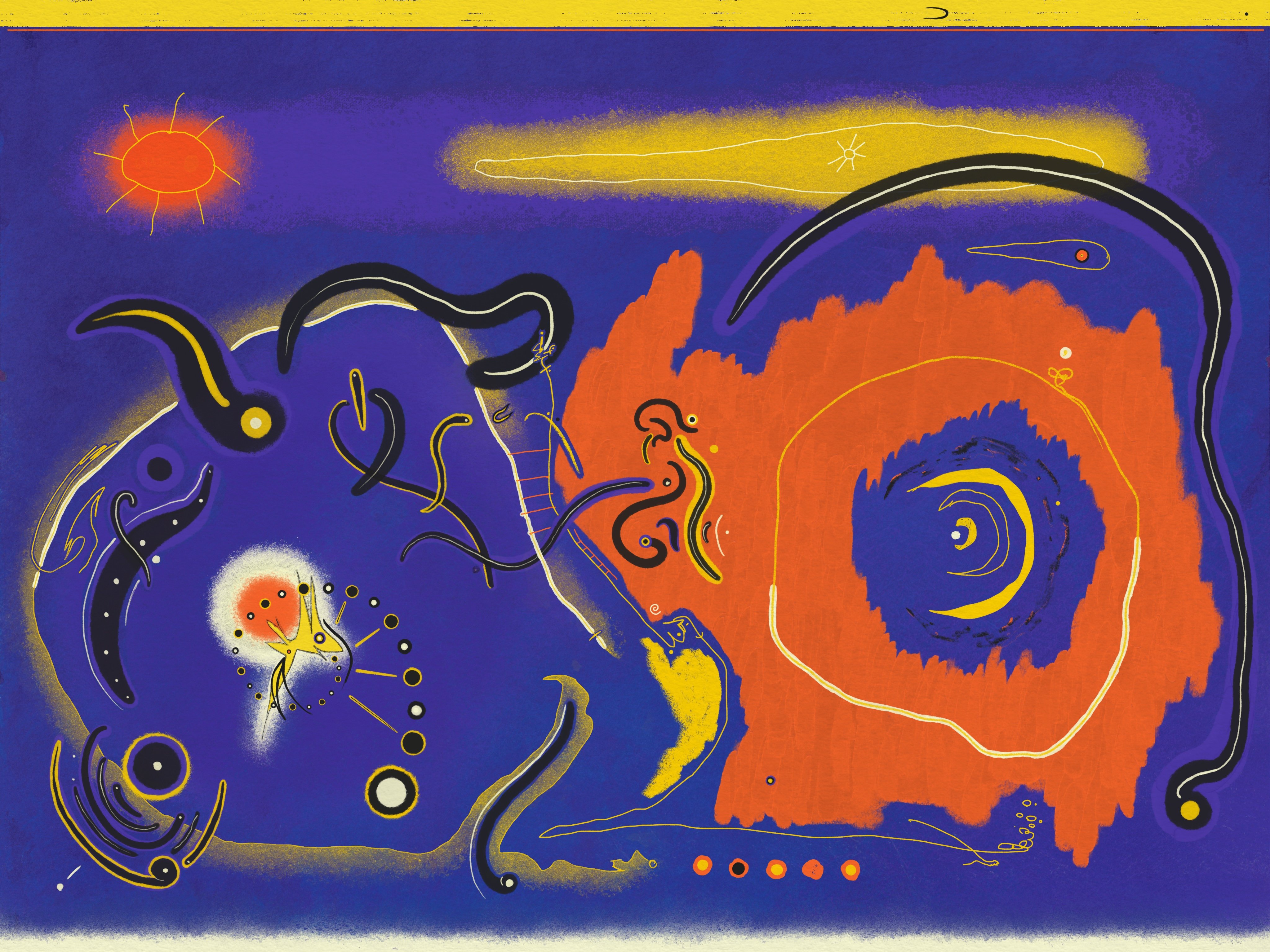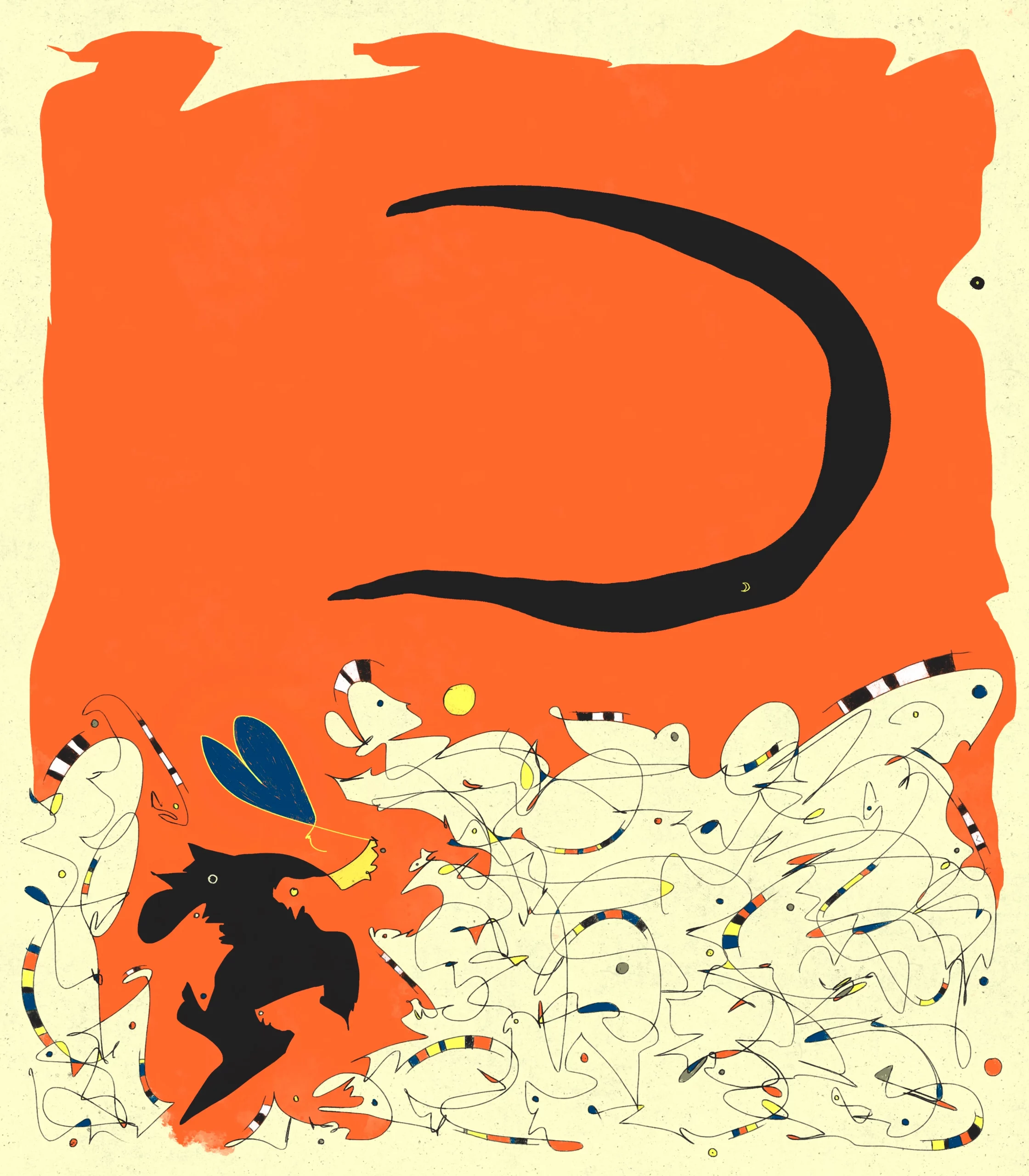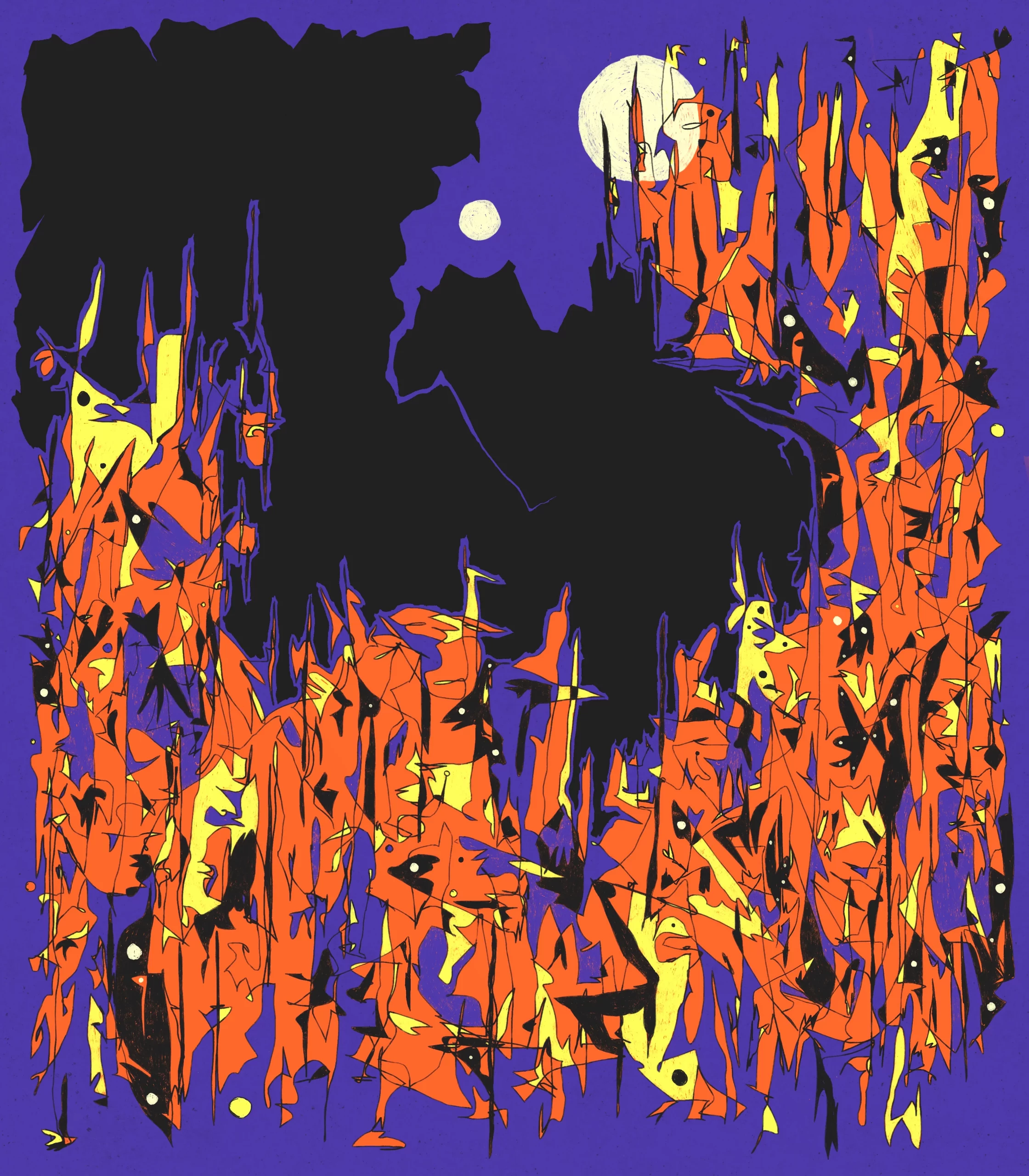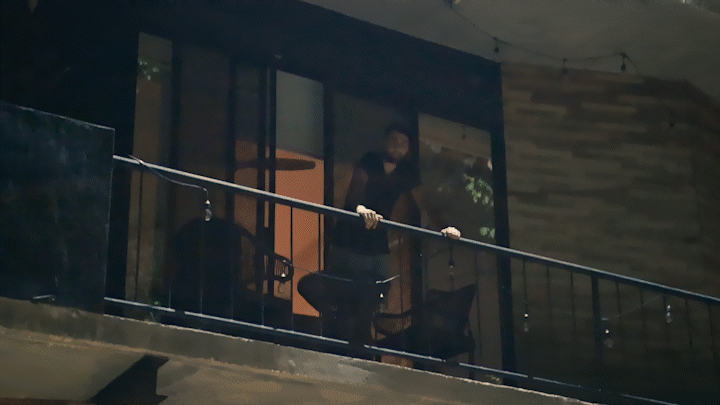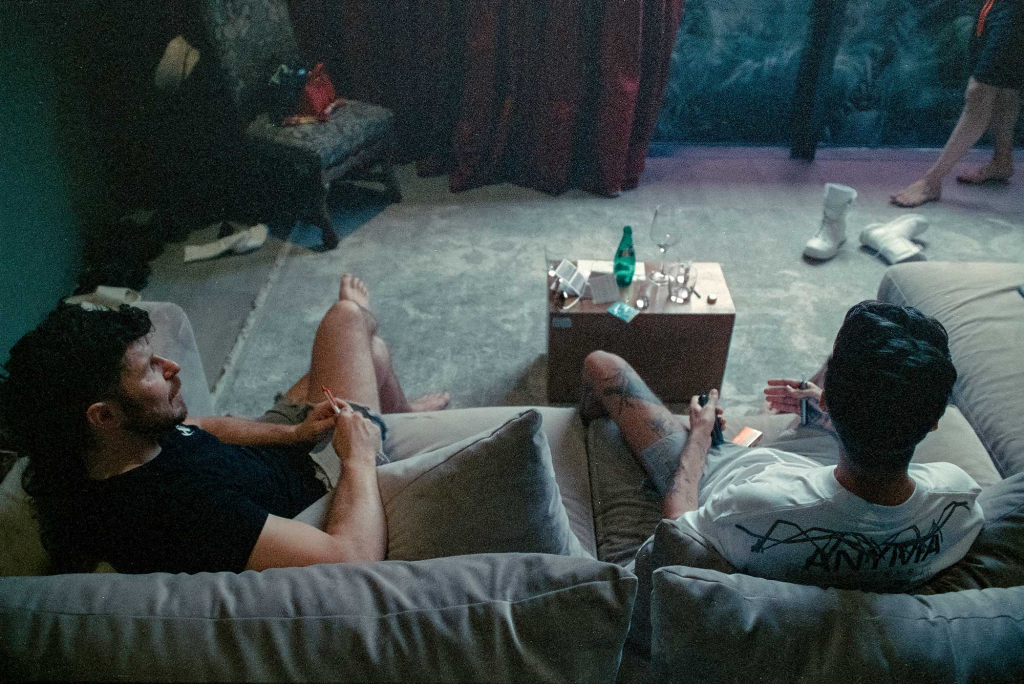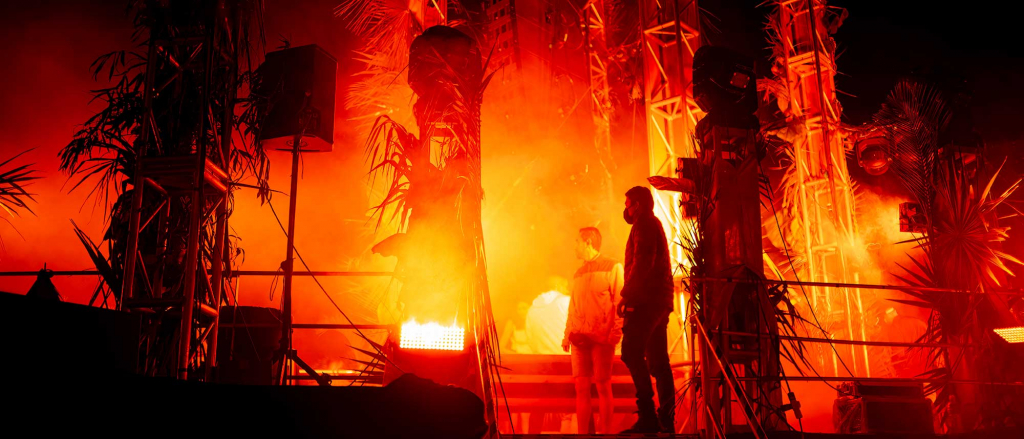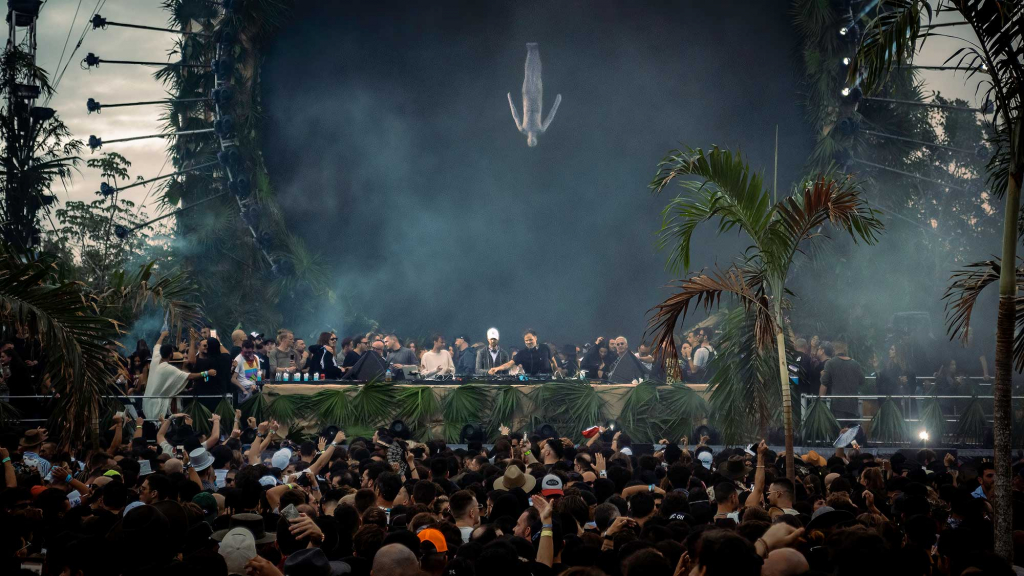SuperRare Labs Senior Curator An interviews ALIENQUEEN about psychedelics, death, and her journey in the NFT space.

Curated Conversations: omentejovem
Above: “Out of Babylon” by omentejovem, 2023. Available now SuperRare.
Thales Machado, or, omentejovem (“the young mind”), as he’s known in digital art circles, is a 21 year old, Brazilian abstract artist known for his fluid, colorful and emotive style. He began work as a designer in his midteens before discovering the NFT art scene in 2020, and focusing his practice around the distinctive, visionary style for which he’s come to be known.
His creative process is organic, a leap of faith that begins with random strokes and lines – a pen guided by the kernel of an idea – and blossoms through curves and bold colors, resulting in artworks that demand the eye and clutch the heart.
Having recently moved back to his hometown in the Brazilian countryside, his most recent piece, “Out of Babylon” symbolizes change – a transition in his practice, and an opportunity to focus his craft, experiment with new techniques and textures, and break new ground as an artist.
At this exciting moment in his career, SuperRare sat down with Thales to discuss his work, creativity in the NFT space, and his vision for the future.
***
SuperRare: Hi Thales, thanks for taking the time to chat. You began doing professional design work at the age of 16, correct? Can you talk a little bit about the start of your career and how you developed your style as an artist?
Thales Machado: Yes, my first experience with Photoshop was doing custom skins for FPS – changing the data of the game – [and creating] covers and arts for my clan. I always loved music and [had] friends that made music, so I started doing covers for them, and other people in my city. I decided to go on Twitter to expand my clients and charge in dollars. My dream at that time was to sell covers for $50. I really started to build my style when I found out about NFTs: I [realized] that the goal of my artwork [isn’t] to fit into someone’s taste or concept, the goal is to make the most beautiful and meaningful thing to me, and the buyer could appear, and I could have this control.
[At] the time I found out about NFTs, I was struggling with design. I had a lot of cool ideas (at least to me), which my team and other people didn’t like, so I always had to empty everything and start again to finish the freelance work. Since I was a kid (around 12 years old or less), [I’ve always] had fun sketching random lines and [finding ways to] bring life to them – putting circles, lines, and adding things – but the start was always random. I embraced this again [and began working] with abstract in a more personal and fluid way.
SR: What drove you to a career as an artist? Where does the impulse come from
TM: Curiosity, need, and vision drove me to a career as an artist. Curiosity to find out about NFTs when I first saw them, need because I knew I could make a living from that (giving that, even if I was selling works for $200, it would be more than what I was making working full time as a designer), and vision to believe it all and quit everything to follow my own path, concepts, and aesthetics, with no compromise to anyone but myself.
The impulse was with Etiene Crauss, a brazilian and cryptoart pioneer in Brazil. When I came to Twitter trying to find international customers, I got into a groupchat of Brazilian artists. Etiene was there and I [looked] up one of his first sales. My first impression was, why? Why would someone pay that [much] for a digital file, which I could save myself? Then he sent me an article by Loopify which made more sense. He sent me some ETH to mint my first artwork “SQUVV?”, one of my first personal works (which, by the way, I [bought] back from a collector in a sleep listing at Rarible), I minted it and, the morning after, it sold. I got ETH in my wallet! I could sell it for dollars and send it anywhere without big bureaucracy or shit – it all made sense. I have played video games since [I was a] kid, I liked CSGO skins, it was very obvious I should keep going.
I find my art fluid, expressive, and personal. It’s easier to tell the truth, and my storytelling is what I feel, what I live, what I [have] experienced.
— omentejovem

“The Day I Met You” by omentejovem, 2022.
SR: What excites you about the NFT art space?
TM: What excites me in the NFT space is that anyone can mint a work and keep a provenance, which everyone can see and access world wide – the future is rich in culture and provenance, even more cool in a timeline when anyone can create images with AI.
SR: Much of your work has a very distinct and visionary style – powerful color combinations, abstract storytelling, a precise attention to detail, as one might expect from a designer – how would you describe your approach to art, creativity, and storytelling?
TM: I feel I’m personally new into art/personal art. I still have to educate myself in many things that can help me in my progress and also creativity, baggage is everything and creativity is nothing more [than a way] to connect one point to another – I find my art fluid, expressive, and personal. It’s easier to tell the truth, and my storytelling is what I feel, what I live, what I [have] experienced. I don’t love to bring “exceptional” and crazy storytelling or concepts to please the viewer, but if I can find truth to myself on what I’m creating and telling, it’s a W to me and I know someone can connect and find truth themselves because we’re all humans sharing experiences and feelings.
SR: As a related follow up question, what would you like people to get from your work, do you go into the creative process with the intention of evoking certain emotions, of conveying ideas, etc?
TM: Most of the time, I [find] the concept in the process. I seek for aesthetics and things that I find beautiful, through fluid, and mostly random, lines. Part of the process is to find beauty – aesthetical compositions, sometimes with intention in the strokes, or random, my life inspires most all of my artworks.
SR: How do you approach the creative process? Where do your ideas come from? What tools do you work with? Does creative inspiration come suddenly, followed by non-stop work until the piece is finished or do you take a more methodical, drawn out approach to working?
TM: My ideas and aesthetics come mostly from my fluid strokes and lines. I love the contrast of colors. [For] part of my career I worked just with Photoshop, now mostly in Procreate. I’m experimenting with physicals offline as well and this has [inspired my] digital [work]. I believe creativity takes work. You need to work and workout everyday. Some of my favorite works, “The Day I Met You”, came from days that I wasn’t that inspired or with a great concept in mind. Others, I prefer to work, watch it some days, work again… with pauses to reflect and take actions.
SR: Can you talk a little bit about the vision behind your latest piece on SuperRare, “Out of Babylon”?
TM: The artwork description best sums it up:
I imagine I will feel better in my hometown where I grew up, surrounded by friends who have been with me since before my journey as ‘omentejovem,’ and of course, my family. And if I don’t feel better, things are not set in stone, and I will be able to make another decision if I choose to. I believe this change will allow me to travel more and meet other friends along the way. I feel the need for a home and a place where I feel good, with people who make me feel good, with love and less rush and selfishness from the big city.

“THRIVING THROUGH ILLUSION” by omentejovem, 2021.
I just create: Random lines, seeking beauty, aesthetics, and I [find] the concept in the process
— omentejovem
SR: What about the process? How did you go about creating the work?
TM: I just create: Random lines, seeking beauty, aesthetics, and I found the concept in the process – change, many things… I would like to [make a process video] to show how random and fluid it is, but, at the same time, slow and thoughtful.
SR: Anything else you’d like people to know about this piece and how it fits into your body of work or ideas for future projects?
TM: I am excited to continue studying and creating better pieces, textures, colors choices, etc, and I think I could get something nice from this work. It’s inspiring me to work [on] my next one that is nearly finished.
SR: Let’s talk a little bit about some of your previous work. I love the piece, “Peixe-Dourado no AZul,” can you talk a little bit about that artwork, the vision behind it and the creative process?
TM: It was interesting to work with the BLeU piece by Tjo. I remember [this was] one of the first pieces [in which] I used some brushes. At that time, I was starting on the path to study and [add] more depth and curiosity to my paintings via aesthetics and details.
SR: What about the process? How did you go about creating the work?
TM: I just create: Random lines, seeking beauty, aesthetics, and I found the concept in the process – change, many things… I would like to [make a process video] to show how random and fluid it is, but, at the same time, slow and thoughtful.
SR: Anything else you’d like people to know about this piece and how it fits into your body of work or ideas for future projects?
TM: I am excited to continue studying and creating better pieces, textures, colors choices, etc, and I think I could get something nice from this work. It’s inspiring me to work [on] my next one that is nearly finished.
SR: Let’s talk a little bit about some of your previous work. I love the piece, “Peixe-Dourado no AZul,” can you talk a little bit about that artwork, the vision behind it and the creative process?
TM: It was interesting to work with the BLeU piece by Tjo. I remember [this was] one of the first pieces [in which] I used some brushes. At that time, I was starting on the path to study and [add] more depth and curiosity to my paintings via aesthetics and details.
SR: Do you feel like NFT art is becoming more accepted by the traditional art world? Do you see a merger of these communities in the future?
TM: Yes, people are buying, they want money, but the culture is also being built. You can’t deny all [of] what we’re building, all what we’re creating, and the big provenance value of the artists nowadays in the WWW. We need to figure out how to display digital better, but still images are still my favorite given you can experience them in print, which I prefer. I also send high quality, signed prints to 1/1 collectors, with certificate and NFC token.
SR: How important are your roots as a Brazilian to your work? Is representation and cultural storytelling something of importance to you as an artist?
TM: I can see much of Brazil in my artworks. [In] past times I would [have] said “no,”, but I can’t [deny that] I live in Brazil. I love [it] here besides things. “Musician at Ipanema’s Beach” shows a little of that. My colorful works could [be seen as] validating this idea. People maybe have a colorful view of Brazil, the culture, forests, beaches, carnival etc. But honestly, other artists are doing better themed artworks than myself I think.
SR: Are there other artists, trends, or movements in the space that excite you at the moment?
TM: I love all my artists friends. I won’t tag them all here because is a lot and I will forget many, mainly those I see almost everyday in TL and it is familiar. It’s very exciting to see the same faces I saw when I joined 2020 and 2021. We’re definitely building something here. It excites me to be part of this community and culture, and to have so many great artists and humans around.
Tech






Out of the Vault and onto the Chain: the Evolving Nature of Provenance
SuperRare editor Oli Scialdone considers the social experience of provenance and its relationship with community in the Web3 space.
Curators' Choice











Curated Conversations: ALIENQUEEN
SuperRare Labs Senior Curator An interviews ALIENQUEEN about psychedelics, death, and her journey in the NFT space.

